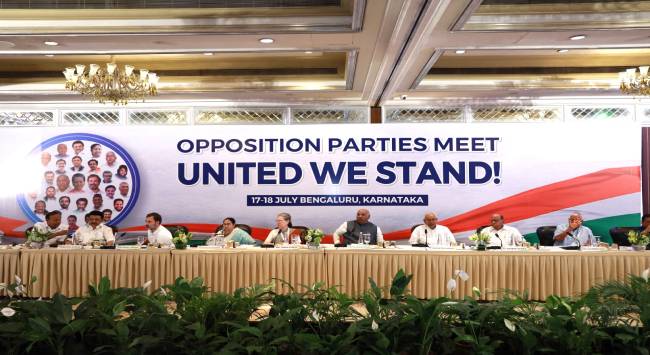Summary
On 18 July 2023, 26 opposition parties, including the Indian National Congress, came together in Bengaluru to announce the formation of an alliance called ‘INDIA’ (Indian National Developmental Inclusive Alliance). While it has coordinated during the ongoing monsoon session of the Indian parliament to put pressure on the government, its strategy and efficacy will be tested in the run-up to the 2024 general elections.
The Indian general elections are not likely to be held before early 2024, but electoral calculations are very much on the minds of all political parties. On 18 July 2023, 26 opposition parties, including the Indian National Congress, came together in Bengaluru to announce the formation of an alliance called ‘INDIA’ (Indian National Developmental Inclusive Alliance).
There are two aspects to the formation of the opposition alliance – the first is symbolic while the second is electoral. The very fact that a large number of the main opposition parties have come together on a common platform to oppose the Bharatiya Janata Party (BJP) in the 2024 elections sends out a message of unity – something that the opposition has not been able to do in the last two general elections. The name of the alliance, INDIA, is also a smart one. By zeroing in on ‘INDIA’ – apparently a suggestion of West Bengal Chief Minister Mamata Banerjee – the opposition is attempting to reclaim the nationalist space which has so effectively been occupied by the BJP since 2014 when it was voted to power.
However, there are plenty of hurdles to surmount on the alliance’s electoral compatibility. First, of the 26 parties that have come together, there are a few who are rivals at the state level. For instance, in West Bengal, the Trinamool Congress (TMC) and the Left parties are bitter rivals. The same applies to the Congress and Left who have a long and historic rivalry in Kerala. Again, in New Delhi and Punjab, the Congress and the Aam Aadmi Party (AAP) have traditionally been pitted against each other. That rivalry is also complicated by the fact that the AAP has aspirations of filling the space occupied by the Congress in states such as Gujarat or Himachal Pradesh where there are no strong regional parties.
Second, there are several states where the aggregation of opposition votes will not make much of a difference. In states like West Bengal, the dominant regional party, the TMC, does not need allies to fight the BJP. Indeed, an electoral understanding with other opposition parties could even harm the TMC’s electoral prospects. There are states like Tamil Nadu or Kerala where the BJP is a marginal force. As such, an opposition alliance makes little sense. In fact, in states, such as Bihar or Maharashtra, where an opposition alliance could make a difference, there is already one in place.
Third, there are several other states, mainly in north India, where the contest is between the BJP and the Congress, and no other opposition party has a meaningful presence.
Fourth, some major opposition parties, such as Biju Janata Dal in Odisha, Bharat Rashtra Samithi in Telangana and Yuvajana Sramika Rythu Congress Party in Andhra Pradesh, are not part of the opposition alliance.
Finally, the leadership ambitions of the various regional leaders could scuttle the alliance experiment. However, most of them have been at pains, at least for the time being, to disassociate themselves from ambitions of leadership positions.
That the opposition alliance has had an impact on the BJP is apparent. It was no coincidence that on the same day, the ‘INDIA’ alliance was announced, 38 parties – a majority of them very small players – gathered under the banner of the BJP-led National Democratic Alliance to pledge their allegiance to Prime Minister Narendra Modi in the 2024 election.
The name of the opposition alliance seems to have touched a raw nerve in the BJP. Several BJP leaders have attacked the adoption of ‘INDIA’ as the name for the opposition alliance and the party’s chief minister in Assam, Himanta Biswa Sarma, has removed ‘India’ from his Twitter bio. Modi also seems to be riled by the name of the opposition alliance. In a recent speech, he said that voters will not be deceived by the opposition invoking the country’s name. He sought to undermine the opposition alliance by noting that the British East India Company and the terrorist organisation, Indian Mujahideen, had ‘India’ in their names.
While the strength and impact of the opposition alliance will be tested in the run-up to the 2024 election, the opposition has coordinated during the ongoing monsoon session of the Indian parliament to put pressure on the government. In the aftermath of the circulation of horrific images of sexual assault on women from the northeastern state of Manipur, the opposition has tabled a no-confidence motion against the BJP. While the motion has no chance of succeeding, due to the BJP’s majority in parliament, it is meant to force the prime minister to speak on Manipur, an issue he has remained silent on except for a brief statement to reporters on 20 July 2023.
The back and forth between the opposition alliance and the government is sure to intensify in the days to come.
. . . . .
Dr Ronojoy Sen is a Senior Research Fellow and Research Lead (Politics, Society and Governance) at the Institute of South Asian Studies (ISAS), an autonomous research institute at the National University of Singapore. He can be contacted at isasrs@nus.edu.sg. The author bears full responsibility for the facts cited and opinions expressed in this paper.
Pic Credit: Mallikarjun Kharge’s Twitter Account
-
 More From :
More From :
-
 Tags :
Tags :
-
 Download PDF
Download PDF


